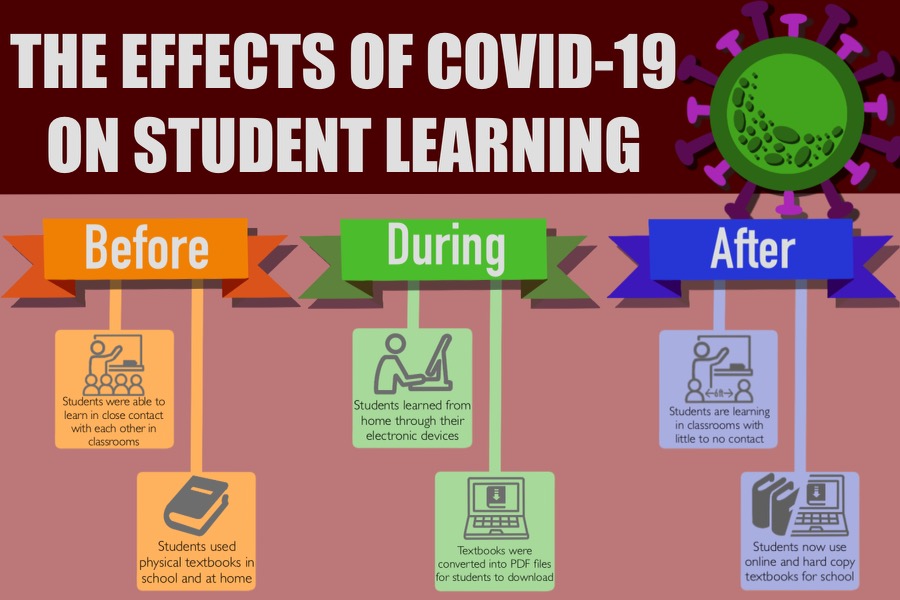The impact of COVID-19 on America’s schools
COVID-19 has impacted the American school system in multiple ways.
September 9, 2021
Last year, with little-to-no notice, teachers and students alike found themselves in the middle of a huge national experiment in discovering new ways to teach and learn through virtual mediums.
The COVID-19 pandemic disrupted almost every aspect of traditional schooling and forced educators to rapidly adapt in order to fit the needs of the student body. The movement of classes to an online setting resulted in the reliance on sites like Canvas, Zoom, and Microsoft Teams to get through the school day, with the majority of schoolwork expected to be submitted virtually.
However, transitioning from in-person to remote learning was more than just a switch from classrooms to computers. While in-person schooling has resumed for the majority of students for the 2021-22 school year, the pandemic has challenged our basic ideas of what school should look like from attendance, to technology, to funding, and the role human connections play in education.
For one, completing a full year of school online has changed the way teachers connect with their students. Many teachers use communication apps, such as Remind, to quickly get into contact with their students outside the confines of the physical classroom.
“I think Remind is helpful because if the student is confused on an assignment or concept and wants additional help they have a way to easily get in touch with their teacher,” Marjory Stoneman Douglas High School junior Jolie Wainland said.
These apps were especially useful during remote learning when teachers needed to notify students of technology issues that caused the classes to be paused or delayed. As in person classes commence, the use of communication apps helps students to be kept in the loop about test dates, changes with homework, general updates, and so on.
Additionally, many school districts across the nation are planning to embrace an online learning program even after the pandemic induced remote learning is behind us.
Virtual classes benefit a wide range of individuals such as those who face extreme social anxiety or bullying and would prefer to learn in the comfort of their own environment. Online classes can be valuable for students who have to manage school with a job as well as those who suffer from chronic illnesses and have to constantly miss class. The program is attractive to students who like some aspects of homeschooling, but still want to have connections to a formal organization.
Furthermore, having the capability to host online sessions would be helpful in the case of wildfires, blizzards, and other events that limit the students’ abilities to get to a physical classroom. Continuing classes online would maximize student learning time and keep them on track.
Online classes also expand student access to less-common courses. For example, if one high school offers a class in Mandarin, students at another school could join it remotely.
The COVID-19 pandemic has proven that remote learning is not for everyone as the percent of students with failing grades doubled. However, for many other students the opportunity will be life changing.
Secondly, many teachers have started to rely more on Canvas, a learning management system, to post course materials and the weekly agenda for the students.
Using Canvas helps students to clearly see what will be expected of them in the coming weeks and can easily see the PDFs, textbooks and links their teachers have provided for them. Keeping these courses up to date ensures that students who have to miss a class period will be able to easily catch up and stay on track.
The pandemic has also permanently changed the college admissions process. For decades, the SAT and ACT have been a mandatory part of applying to college. However, for the class of 2021, many competitive universities across the nation decided to change their admissions process, acknowledging the multitude of hardships students have faced over the past year that may have prohibited them taking and getting a decent score on the tests.
In a survey conducted by ACT, many colleges claimed that they were unlikely to return to requiring the tests in the future. Over the next few years, colleges will learn whether eliminating the testing mandate means they will be enrolling a more economically and racially diverse class of students. Additionally, universities will be able to see how students admitted without test scores do compared to those who submitted theirs.
“I’m really intrigued by the fact that this change could take place,” junior Tilak Patel said. “Having the ability to not submit my test scores might affect where I decide to apply to college.”
Another change the pandemic has brought to the school system is the importance of student’s mental health. The mental health battles of the nation’s students will outlast the pandemic and thus require school districts to create a strong system of support for the student body.
Researchers say they have noticed an increasing number of students who are depressed or anxious. Furthermore, over 75 percent of students who receive treatment for their mental health do so at school.
As the demand for mental health care rises, school districts have had to adapt through hiring more counselors and mental health providers. Some schools have hired therapists to aid students on campus.
Additionally, a new app entitled “Tell Another. Listening is Key” (T.A.L.K.) was published on students’ learning platforms, providing students the opportunity to confidentially request mental health support or report abuse.
For the majority of students, our days of remote learning have been put behind us. In-person classes resume, clubs are able to host events, sports seasons commence and students have been able to regain some sense of normalcy.
In the past, the American school system has been criticized for its resistance to change. However, the past year has shown that the system can be changed to better meet the needs of students across the nation.













